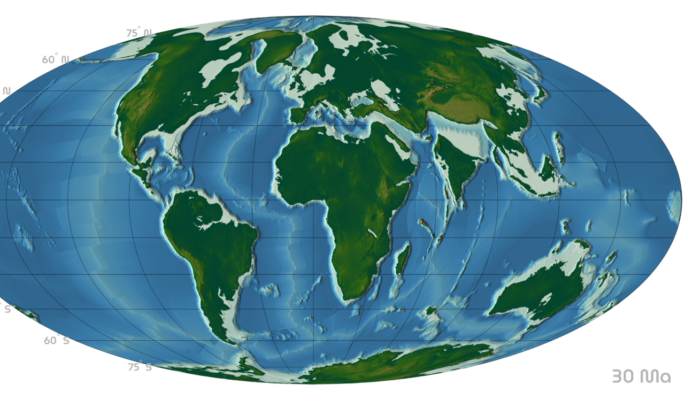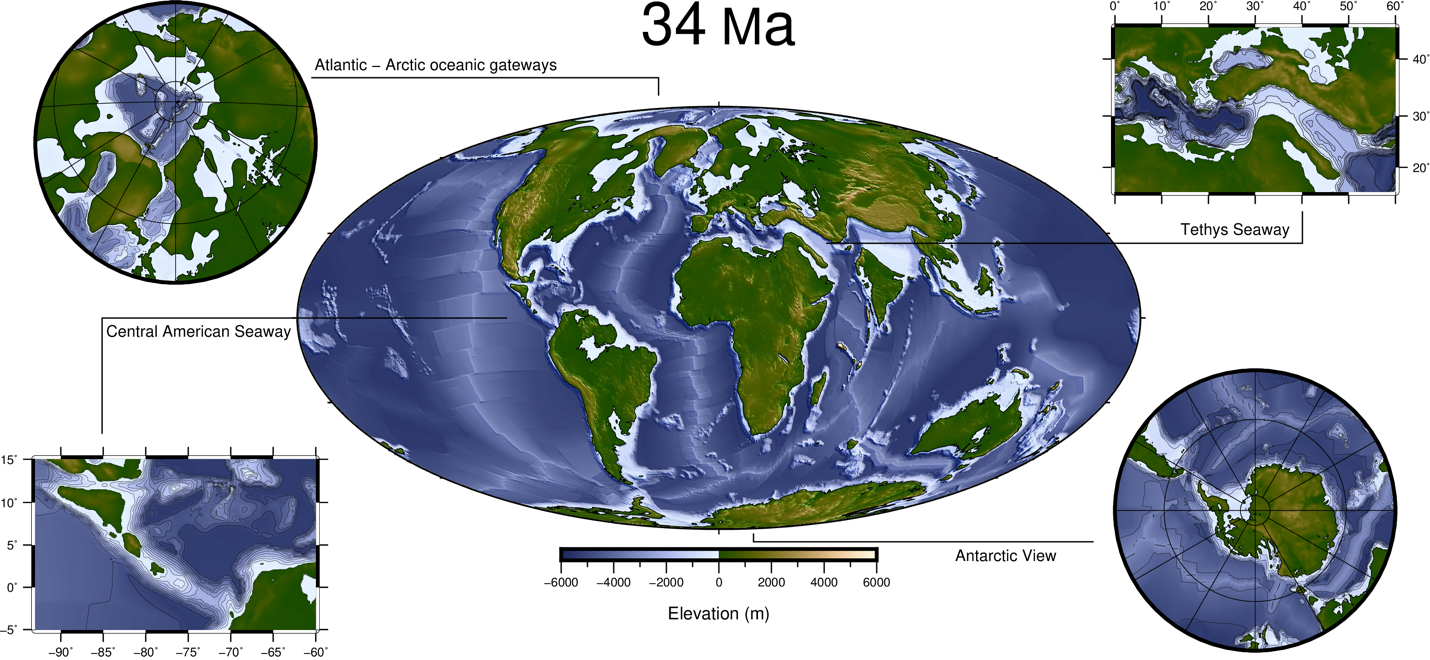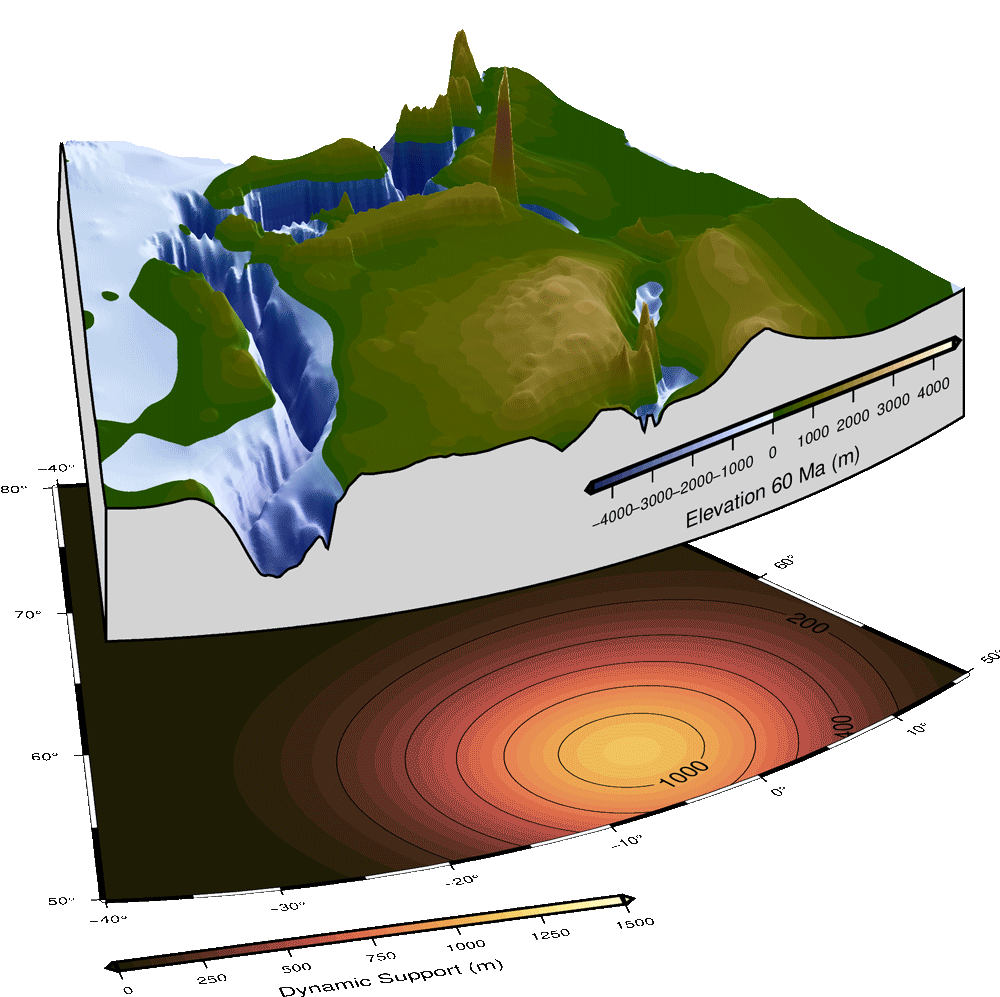
 Eivind Straume a Postdoctoral fellow at the Department of Geological Sciences within the Jackson School of Geosciences explores how the opening and closing ocean gateways have influenced the Earth’s climate in the past.
Eivind Straume a Postdoctoral fellow at the Department of Geological Sciences within the Jackson School of Geosciences explores how the opening and closing ocean gateways have influenced the Earth’s climate in the past.
Changes in Earth’s geography due to tectonic plate motions and mantle convection influence climate evolution on geological timescales. Over millions of years, continents move with respect to the Earth’s climate zones changing the local climate, ocean basins open and close shaping the global ocean circulation, while mountains form and erode away, influencing atmospheric winds and rain patterns. It is therefore very important to account for past geography (paleogeography) when studying and modelling the climates of the geological past.
Oceanic gateways
An important part in this picture is the evolution oceanic gateways linking the world’s major oceanic basins. Oceanic gateways are significant as even small depth variations in these regions can potentially cause large changes in ocean circulation and climate over relatively short periods of time (geologically speaking). However, the paleogeography of several of the most famous oceanic gateways (see Figure 1 & accompanying movie here), including their timing of opening or closure, are not well constrained, and their role in past climatic changes are not known.

Figure 1. The of Cenozoic paleogeography of Straume et al. (2020), and the evolution of key oceanic gateways.
With the aim of building better paleogeographic reconstructions for paleoclimate modelling, a recent study by Straume et al. (2020) made a new global paleogeography model and investigated the evolution the Northern Hemisphere oceanic gateways for the last 66 million years (i.e. the Cenozoic era). During this time the Tethys Seaway closed (Figure 1 & movie), which ended a circum-equatorial connection of the world’s oceans. At the same time, the Northeast Atlantic Ocean opened, creating a deep water gateway from the Atlantic to the Arctic Ocean and the Central American Seaway closed terminating the exchange of Atlantic and Pacific Ocean waters. While concurrently in the South, the Southern Ocean gateways (i.e., the Drake Passage and Tasman Gateway) also opened.
As these gateway events modified the global ocean circulation pattern, the Earth’s climate changed from a warm greenhouse with hot polar regions and no large continental ice sheets, to today’s cold icehouse climate with glaciated poles and stronger latitudinal temperature gradients (e.g., Zachos et al., 2008). Many previous studies point to the role of the Southern Ocean gateways in the Cenozoic greenhouse–icehouse transition. The opening of the Southern Ocean is believed to have enabled the flow of the Antarctic circumpolar current, which contributed to thermal isolation of Antarctica, and the growth of the first Antarctic ice-sheets ~34 million years ago at the Eocene-Oligocene transition (e.g., Kennett, 1977; Lawver and Gahagan, 2003; Livermore et al., 2005). However, Straume et al. (2020) also points towards changes in the Northern Hemisphere gateways at that time, especially the Atlantic – Arctic (the Greenland-Scotland Ridge and the proto-Fram Strait/Barents Sea) and the Tethys Seaway. The paleogeographic changes in these regions could have influenced the overturning circulation in the Atlantic Ocean, and thereby the global latitudinal heat transport (e.g. Wright and Miller, 1996; Zhang et al., 2011; Abelson and Erez, 2017). Alongside decreasing atmospheric CO2 levels, these seaways could have played a role in enabling the modern ocean circulation and climate.
Interestingly, some of the gateway-induced climate variations may be rooted in processes originating deep within the Earth.

Figure 2: Paleogeography of the Northeast Atlantic region and dynamic support from the Iceland mantle plume. From Straume et al. (2020).
From deep earth mantle flow to climatic changes (An example from the North Atlantic)
The large-scale changes in bathymetry and topography over millions of years are closely linked to plate tectonics, however, their evolution is also influenced by deeper processes like mantle convection. The Northeast Atlantic region showcase a potential link a between such deep earth processes and climate variations, through topographic changes of the Atlantic – Arctic oceanic gateways. In this region, the paleogeography has been influenced by the presence of the Iceland mantle plume. Ever since Greenland and Eurasia drifted apart ~54 million years ago (Gaina et al., 2009), a combination of volcanic activity and dynamic support from the mantle below has kept the Greenland – Scotland Ridge at shallow depths for most of this time. Simultaneously, variations in the plume activity have caused episodes of uplift and subsidence which would have influenced ocean flow across the ridge (Wright and Miller, 1996; Parnell-Turner et al., 2014). Today, this region is important for deep water formation in the North Atlantic which is a key component in the Atlantic overturning circulation, and this may also have been true for the past (Abelson and Erez, 2017; Hutchinson et al., 2019). Therefore, topographic changes in the Northeast Atlantic due to deep earth/mantle plume variations could have impacted regional and global ocean circulation and climate by controlling the Atlantic overturning circulation. To account for this, the influence from the Iceland plume is included in the new paleogeography model (Figure 2).
In summary, the Earth solid surface is constantly changing due to plate motions and mantle convection. Such changes in geography play an important role in global ocean circulation and climate on geological timescales. During the last 66 million years, the evolution oceanic gateways in both hemispheres caused ocean circulation changes and alongside decreasing atmospheric CO2, they may have played a key role in the transition from a warm greenhouse climate the cold icehouse climate we are in today (at least for now).
References Abelson, M., and Erez, J., 2017, The onset of modern-like Atlantic meridional overturning circulation at the Eocene-Oligocene transition: Evidence, causes, and possible implications for global cooling: Geochemistry, Geophysics, Geosystems, v. 18, no. 6, p. 2177-2199. Eldrett, J. S., Harding, I. C., Wilson, P. A., Butler, E., and Roberts, A. P., 2007, Continental ice in Greenland during the Eocene and Oligocene: Nature, v. 446, no. 7132, p. 176-179. Gaina, C., Gernigon, L., and Ball, P., 2009, Palaeocene–Recent plate boundaries in the NE Atlantic and the formation of the Jan Mayen microcontinent: Journal of the Geological Society, v. 166, no. 4, p. 601-616. Hutchinson, D. K., Coxall, H. K., OʹRegan, M., Nilsson, J., Caballero, R., and de Boer, A. M., 2019, Arctic closure as a trigger for Atlantic overturning at the Eocene-Oligocene Transition: Nature Communications, v. 10, no. 1, p. 3797. Kennett, J. P., 1977, Cenozoic evolution of Antarctic glaciation, the circum‐Antarctic Ocean, and their impact on global paleoceanography: Journal of geophysical research, v. 82, no. 27, p. 3843-3860. Lawver, L. A., and Gahagan, L. M., 2003, Evolution of Cenozoic seaways in the circum-Antarctic region: Palaeogeography, Palaeoclimatology, Palaeoecology, v. 198, no. 1, p. 11-37. Livermore, R., Nankivell, A., Eagles, G., and Morris, P., 2005, Paleogene opening of Drake passage: Earth and Planetary Science Letters, v. 236, no. 1, p. 459-470. Parnell-Turner, R., White, N., Henstock, T., Murton, B., Maclennan, J., and Jones, S. M., 2014, A continuous 55-million-year record of transient mantle plume activity beneath Iceland: Nature Geosci, v. 7, no. 12, p. 914-919. Straume, E. O., Gaina, C., Medvedev, S., and Nisancioglu, K. H., 2020, Global Cenozoic Paleobathymetry with a focus on the Northern Hemisphere Oceanic Gateways: Gondwana Research, v. 86, p. 126-143. Wright, J. D., and Miller, K. G., 1996, Control of North Atlantic deep water circulation by the Greenland-Scotland Ridge: Paleoceanography, v. 11, no. 2, p. 157-170. Zachos, J. C., Dickens, G. R., and Zeebe, R. E., 2008, An early Cenozoic perspective on greenhouse warming and carbon-cycle dynamics: Nature, v. 451, no. 7176, p. 279-283. Zhang, Z., Nisancioglu, K., Flatøy, F., Bentsen, M., Bethke, I., and Wang, H., 2011, Tropical seaways played a more important role than high latitude seaways in Cenozoic cooling: Climate of the Past, v. 7, no. 3, p. 801-813.
